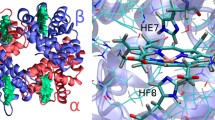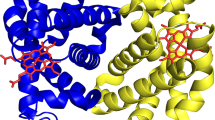Abstract
The homology model of hemoglobin D from Geochelone carbonaria, the red-footed tortoise was predicted using the 3D structure coordinates of Geochelone gigantea hemoglobin D as the template. The model was built using the program, MODELLER (8v1) and evaluated with PROCHECK and PROSA. The present study features an in-depth analysis of the 3D model and its conformational changes brought about with variations in its environment. These structural changes are correlated with its ability to adapt to different environmental constraints enabling the organism to better suit to its natural habitat. The model shows additional contacts between amino acid pairs of α-119 and β-55, α-35 and β-124, α-103 and β-112, α-115 and β-116, α-120 and β-52, α-120 and β-55, α-36 and β-127 which are not found in human hemoglobin. It is predicted that these contacts may result in T-state stabilization thus lowering oxygen affinity. Furthermore, decrease in the interaction of phosphate heteroatoms with the amino acid residues of G. carbonaria Hb was also predicted in this study.









Similar content being viewed by others
Abbreviations
- Hb:
-
Hemoglobin
- Rmsd:
-
Root mean square deviation
- H-bonds:
-
Hydrogen bonds
- DPG:
-
2,3,diphosphoglycerate
- IHP:
-
Inositol hexaphosphate
References
Stepuro TL, Zinchuk VV (2006) J Phys Pharmacol 57:29–38
Giardina B, Mosca D, De Rosa MC (2004) Acta Physiol Scand 182:229–244
Hourdez S, Weber RE (2005) J Inorg Biochem 99:130–141
Riggs A (1964) Can J Biochem 42:763–775
Brown JL, Ingram VM (1974) J Biol Chem 249:3960–3972
Hagopian HK, Ingram VM (1971) J Cell Biol 51:440–451
Monica BM, Silvana B, Adriana SSD, Satie HO, Torsoni MA, Sara TO, Costa FF (2003) Comp Biochem Phys B 134:389–395
Torsoni MA, Stoppa GR, Turra A, Ogo SH (2002) Braz J Biol 62:725–733
Torsoni MA, Ogo SH (1995) Braz J Med Biol Res 28:1129–1131
Castano M, Olga V, Lugo MR (1981) Cespedesia 10:55–122
Torsoni MA, Viana RI, Stoppa GR, Barros BF, Cesquini M, Ogo SHJ (1996) Biochem Mol Biol Int 40:355–364
Perutz MF (1989) Q Rev Biophys 22:139–236
Bairoch AB, Boeckmann B (1991) Nucleic Acid Res 19:2247–2249
Althschul SF, Madden TL, Scaffer AA, Zhang J, Zhang Z, Miller W, Lipman DJ (1997) Nucleic Acid Res 25:3389–3402
Pearson WR (1990) Methods Enzymol 183:63–98
Kuwada T, Hasegawa T, Satoh I, Ishikawa K, Shishikura F (2003) Prot Pept Lett 10:422–425
Berman HM, Westbrook J, Feng Z, Gilliland G, Bhat TN, Weissig H, Shindyalov IN, Bourne P (2000) Nucleic Acid Res 28:235–242
Thompson JD, Gibson TJ, Plewniak F, Jeanmougin F, Higgins DG (1997) Nucleic Acids Res 25:4876–4882
Sali A, Blundell TL (1993) J Mol Biol 234:779–815
Laskowski RA, MacArthur MW, Moss DS, Thornton JM (1993) J Appl Cryst 26:283–291
Sippl MJ (1993) Proteins 17:355–362
Monique L, Istvan K, Takashi Y, Judit F (2005) FEBS Lett 579:627–632
Wallace AC, Laskowski RA, Thornton JM (1995) Prot Eng 8:127–134
Goodman JM (1998) ChemWeb.com journal, the Alchemist
Felsenstein J (1989) Cladistics 5:164–166
Pomponi M, Gavuzzo E, Bertonati C, Derocher AE, Lydersen C, Wiig O, Kovacs KM (2004) Biochimie 86:927–932
James EK, Marcos AO, Qiang X, Stephen R, Austen FR, Marvin LH (1999) J Biol Chem 274:6411–6420
Petruzzelli R, Gabriella A, Amalia L, Antonio G, Alessandro D, Bruno G (1996) Biochem J 316:959–965
Bordin S, Meza AN, Saad STO, Ogo SH, Costa FF (1997) Biochem Mol Biol Int 42:25–260
Bettati S, Mozzarelli A, Perutz MF (1998) J Mol Biol 281:581–585
Liu XZ, Li SL, Jing H, Liang YH, Hua ZQ, Lu GY (2001) Acta Cryst D57:775–783
Liang YH, Liu XZ, Liu SH, Ying GL (2001) Acta Cryst D57:1850–1856
Perutz MF (1970) Nature 228:726–739
Shih DT, Luisi BF, Miyazaki G, Perutz MF, Nagai K (1993) J Mol Biol 230(4): 1291–1296
Riggs AF (1988) Ann Rev Physiol 50:181–204
Perutz MF, Shih DT, Williamson D (1994) J Mol Biol 239(4):555–560
Coletta M, Angeletti M, Ascone I (1999) Biophys J 76:1532–1536
Torsoni MA, Viana RI, Stoppa GR, Cesquini M, Barros BF, Ogo SH (1997) Comp Biochem Physiol 118A:679–684
Riggs A (1998) J Exper Biol 201:1073–1084
Author information
Authors and Affiliations
Corresponding author
Rights and permissions
About this article
Cite this article
Lutfullah, G., Khalil, H.S., Amin, F. et al. Low Oxygen Affinity in Reptilian Hemoglobin D: Prediction of Residue Interactions in Geochelone carbonaria HbD by Homology Modeling. Protein J 27, 141–150 (2008). https://doi.org/10.1007/s10930-007-9117-9
Published:
Issue Date:
DOI: https://doi.org/10.1007/s10930-007-9117-9




